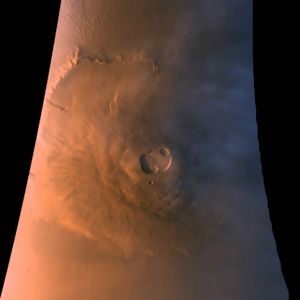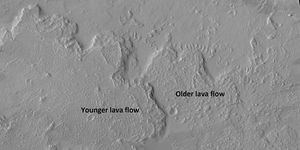Olympus Mons
Olympus Mons is a dormant shield volcano in the Tharsis region. It is the highest point on Mars. By one measure, it has a height of nearly 22 km (13.6 mi or 72,000 ft).[1] Olympus Mons stands about two and a half times as tall as Mount Everest's height above sea level. It is the youngest of the large volcanoes on Mars. It is currently the largest volcano discovered in the Solar System and had been known to astronomers since the late 19th century as the albedo feature Nix Olympica (Latin for "Olympic Snow"). Its mountainous nature was suspected well before space probes confirmed its identity as a mountain.[2]
The volcano is located in Mars's western hemisphere at approximately 18.65 N and 226.2 E, just to the northwestern edge of the Tharsis bulge. The western portion of the volcano lies in the Amazonis quadrangle and the central and eastern portions in the Tharsis quadrangle.
The typical atmospheric pressure at the top of Olympus Mons is about 12% of the average Martian surface pressure.[3]
Various observations show that Olympus Mons has a composition of 44% silicates, 17.5% iron oxides, giving the planet its red coloration, 7% aluminum, 6% magnesium, 6% calcium, and particularly high proportions of sulfur oxide (7%). These results point to the fact that the surface is mostly composed of basalts and other mafic rocks. Lava flows of this composition would have displayed low viscosity, a watery flow that would have produced a volcano with a very gradual slope.
Even so, high-altitude clouds frequently drift over the Olympus Mons summit, and airborne Martian dust is still present.[4]
Olympus Mons is an unlikely landing location for automated space probes in the near future. The high elevations preclude parachute-assisted landings because of insufficient atmospheric thickness to slow the spacecraft down. Moreover, Olympus Mons stands in one of the dustiest regions of Mars. A mantle of fine dust covers much of the terrain, obscuring the underlying bedrock and possibly making rock samples hard to come by. The dust layer would also likely cause severe maneuvering problems for rovers.[5]

| This article is a stub. You can help Marspedia by expanding it. |
- ↑ "Morphometric Properties of Martian Volcanoes" (2004). J. Geophys. Res. 109. doi:. Bibcode: 2004JGRE..109.3003P.
- ↑ Patrick Moore 1977, Guide to Mars, London (UK), Cutterworth Press, p. 96
- ↑ Public Access to Standard Temperature-Pressure Profiles
- ↑ Hartmann, W.K. A Traveler’s Guide to Mars: The Mysterious Landscapes of the Red Planet. Workman: New York, 2003, p. 300.
- ↑ https://en.wikipedia.org/w/index.php?title=Olympus_Mons&action=edit§ion=1







